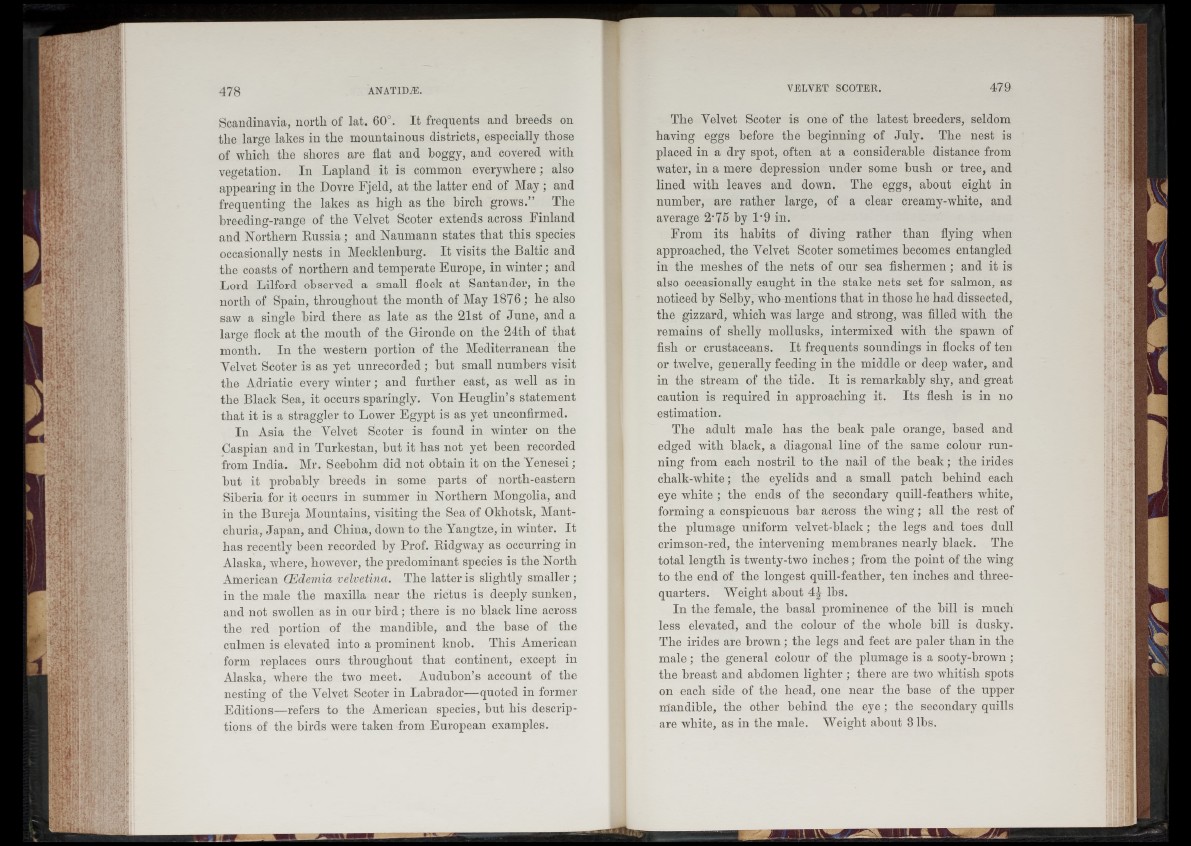
Scandinavia, north of lat. 60°. It frequents and breeds on
the large lakes in the mountainous districts, especially those
of which the shores are flat and boggy, and covered with
vegetation. In Lapland it is common everywhere; also
appearing in the Dovre Fjeld, at the latter end of May; and
frequenting the lakes as high as the birch grows.” The
breeding-range of the Velvet Scoter extends across Finland
and Northern Russia ; and Naumann states that this species
occasionally nests in Mecklenburg. It visits the Baltic and
the coasts of northern and temperate Europe, in winter; and
Lord Lilford observed a small flock at Santander, in the
north of Spain, throughout the month of May 1876; he also
saw a single bird there as late as the 21st of June, and a
large flock at the mouth of the Gironde on the 24th of that
month. In the western portion of the Mediterranean the
Velvet Scoter is as yet unrecorded ; but small numbers visit
the Adriatic every winter ; and further east, as well as in
the Black Sea, it occurs sparingly. Von Heuglin’s statement
that it is a straggler to Lower Egypt is as yet unconfirmed.
In Asia the Velvet Scoter is found in winter on the
Caspian and in Turkestan, but it has not yet been recorded
from India. Mr. Seebohm did not obtain it on the Yenesei;
but it probably breeds in some parts of north-eastern
Siberia for it occurs in summer in Northern Mongolia, and
in the Bureja Mountains, visiting the Sea of Okhotsk, Mant-
cliuria, Japan, and China, down to the Yangtze, in winter. It
has recently been recorded by Prof. Ridgway as occurring in
Alaska, where, hoAvever, the predominant species is the North
American CSclemia velvetina. The latter is slightly smaller ;
in the male the maxilla near the rictus is deeply sunken,
and not swollen as in our bird; there is no black line across
the red portion of the mandible, and the base of the
culmen is elevated into a prominent knob. This American
form replaces ours throughout that continent, except in
Alaska, where the two meet. Audubon’s account of the
nesting of the Velvet Scoter in Labrador—quoted in former
Editions—refers to the American species, but his descriptions
of the birds were taken from European examples.
The Velvet Scoter is one of the latest breeders, seldom
having eggs before the beginning of July. The nest is
placed in a dry spot, often at a considerable distance from
water, in a mere depression under some bush or tree, and
lined with leaves and down. The eggs, about eight in
number, are rather large, of a clear creamy-white, and
average 2-75 by L9 in.
From its habits of diving rather than flying when
approached, the Velvet Scoter sometimes becomes entangled
in the meshes of the nets of our sea fishermen ; and it is
also occasionally caught in the stake nets set for salmon, as
noticed by Selby, who mentions that in those he had dissected,
the gizzard, which was large and strong, was filled with the
remains of shelly mollusks, intermixed with the spawn of
fish or crustaceans. It frequents soundings in flocks of ten
or twelve, generally feeding in the middle or deep water, and
in the stream of the tide. It is remarkably shy, and great
caution is required in approaching it. Its flesh is in no
estimation.
The adult male has the beak pale orange, based and
edged with black, a diagonal line of the same colour running
from each nostril to the nail of the beak; the irides
chalk-white; the eyelids and a small patch behind each
eye white ; the ends of the secondary quill-featliers white,
forming a conspicuous bar across the wing; all the rest of
the plumage uniform velvet-black ; the legs and toes dull
crimson-red, the intervening membranes nearly black. The
total length is twenty-two inches; from the point of the wing
to the end of the longest quill-feather, ten inches and three-
quarters. Weight about 4J lbs.
In the female, the basal prominence of the bill is much
less elevated, and the colour of the whole bill is dusky.
The irides are brown; the legs and feet are paler than in the
male; the general colour of the plumage is a sooty-brown ;
the breast and abdomen lighter ; there are two whitish spots
on each side of the head, one near the base of the upper
mandible, the other behind the eye ; the secondary quills
are white, as in the male. Weight about 3 lbs.